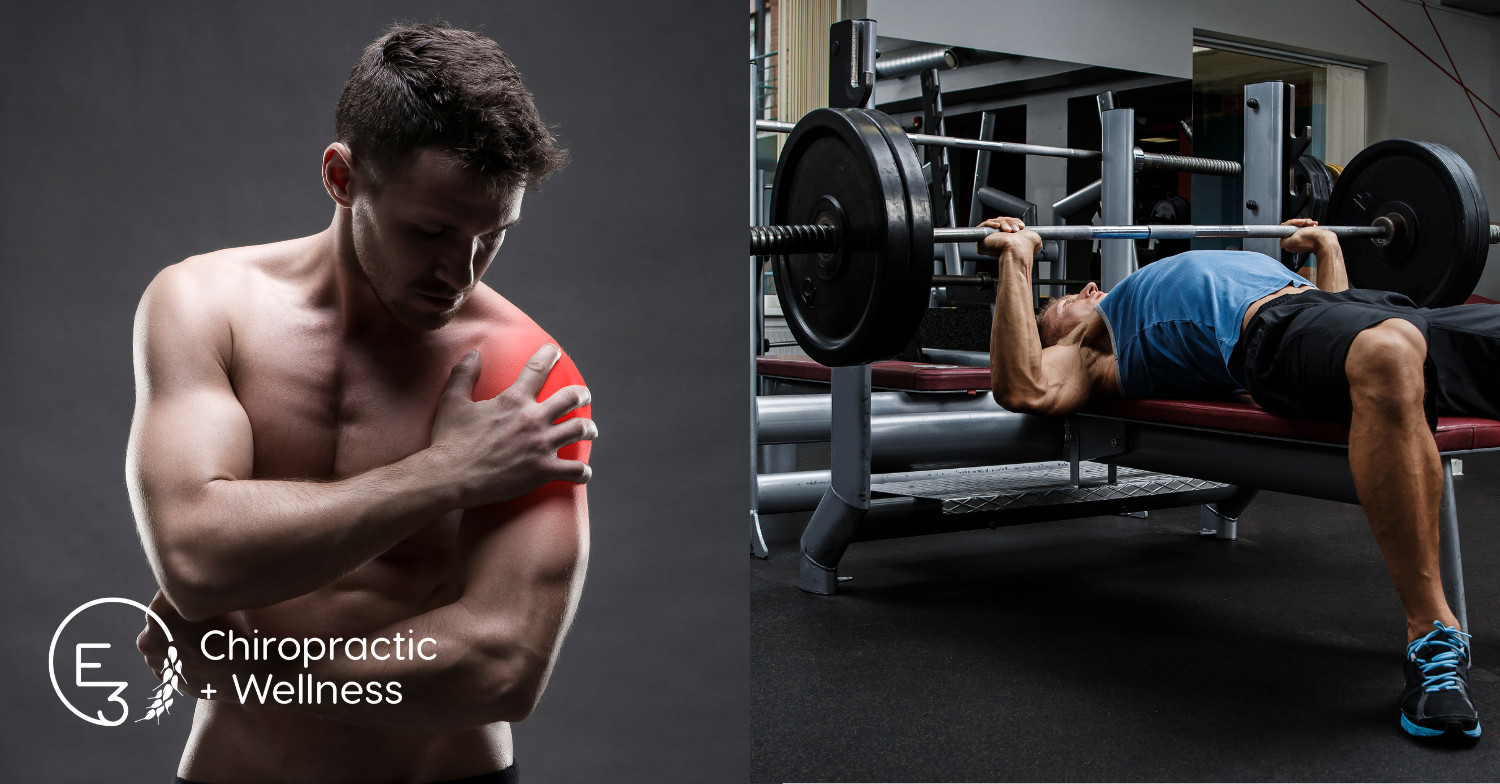
If you’ve ever finished a set of bench presses only to feel a sharp, nagging pain in your shoulder afterward—you’re not alone. Shoulder discomfort is one of the most common complaints among those who regularly lift weights, and bench pressing is often at the center of the issue. As a trusted Saskatoon Chiropractor, the team at E3 Chiropractic + Wellness sees this all the time. The good news? It’s fixable—and often preventable.
In this blog, we’ll explore why your shoulder might be hurting after bench pressing, what’s actually happening beneath the surface, and what you can do to lift pain-free.
The Shoulder Joint: Complex and Vulnerable
To understand why the bench press can cause shoulder pain, let’s break down the anatomy. The shoulder is a ball-and-socket joint with a huge range of motion, but that mobility comes at the cost of stability. The joint relies heavily on surrounding muscles and soft tissues—especially the rotator cuff and scapular stabilizers—to keep everything aligned and functioning properly.
When you bench press, you’re placing a significant load on this complex joint. If your form is even slightly off or your supporting muscles are weak or imbalanced, your shoulders can take a beating.
Common Causes of Shoulder Pain After Bench Pressing
Here are some of the most common culprits:
1. Poor Shoulder Positioning
Many lifters flare their elbows out too wide during the bench press. This can put your shoulders in a vulnerable position, placing excessive stress on the anterior (front) portion of the shoulder and the biceps tendon. Ideally, your elbows should be tucked at a 45-75 degree angle relative to your torso.
2. Rotator Cuff Strain or Impingement
The rotator cuff muscles are responsible for stabilizing the shoulder. When they’re weak or overworked, they can become inflamed or irritated. Repeated poor mechanics during pressing movements can lead to impingement, where tendons are pinched between bones, causing pain and inflammation.
3. Lack of Scapular Control
Your shoulder blades (scapulae) need to move and stabilize properly to support healthy shoulder mechanics. Poor control can lead to compensation and uneven pressure across the shoulder joint. This can be due to weakness in muscles like the serratus anterior or lower traps.
4. Overtraining or Inadequate Recovery
If you’re constantly pushing your body without allowing time for recovery, you risk cumulative overload. The shoulder joint doesn’t have great blood flow, so healing takes time. Without proper rest and muscle care, inflammation builds up.
5. Imbalance in Chest vs. Back Muscles
A strong chest with a weak back is a recipe for shoulder issues. The bench press heavily targets the pectorals, and if not balanced with adequate back training, it can pull the shoulder forward into poor posture, increasing joint stress.
Fixing the Problem: How to Bench Pain-Free
At E3 Chiropractic + Wellness, we believe in a holistic and evidence-informed approach to injury management. If your shoulders hurt after benching, here are some strategies we recommend:
1. Assess Your Form
Sometimes, a few minor tweaks can make a big difference. Here’s what to focus on:
- Keep your feet flat and engaged on the floor.
- Slight arch in your lower back with your glutes on the bench.
- Retract and depress your shoulder blades (“pack” them down and together).
- Tuck elbows slightly to keep the shoulders in a safer path.
2. Strengthen the Rotator Cuff and Scapular Stabilizers
Include accessory exercises like:
- External rotations with a band or dumbbell
- Scapular push-ups
- Face pulls
- Wall slides These help support the joint during heavier lifts and improve long-term function.
3. Mobilize Tight Areas
Many shoulder problems stem from poor thoracic (mid-back) mobility or tight pecs. Use foam rolling and mobility drills to:
- Open up the chest muscles
- Improve upper back extension
- Enhance shoulder blade movement
4. Balance Your Workouts
Ensure your training includes sufficient pulling exercises like rows, chin-ups, and reverse flies. A good rule of thumb: for every bench press day, include a pulling-focused day to even things out.
5. Prioritize Recovery
Sleep, hydration, and nutrition all play a role in joint recovery. Chiropractic care and soft tissue therapy (like ART or myofascial release) can also reduce inflammation and restore mobility.
How E3 Chiropractic + Wellness Can Help
As a leading Saskatoon Chiropractor, E3 Chiropractic + Wellness specializes in helping active adults get out of pain and back to doing what they love. Our unique E3 Approach is built around:
- Finding the root cause of pain (not just treating the symptom)
- Reducing pain quickly using chiropractic care, soft tissue therapy, and rehab techniques
- Rebuilding strength and mobility to prevent future injury
We understand the demands of your sport or gym routine. That’s why our care plans are tailored to your individual goals and lifestyle. Whether you’re a CrossFit athlete, weekend warrior, or just trying to stay strong and mobile—we’ve got your back (and shoulders).
Don’t Let Shoulder Pain Hold You Back
Bench pressing doesn’t have to hurt. With proper mechanics, strategic training, and the right support system, you can press pain-free and perform at your best. If you’re struggling with shoulder pain, don’t wait until it sidelines you completely.
Click HERE to book a free discovery call with E3 Chiropractic + Wellness today. We’ll listen to your concerns, assess what’s going on, and help you map out a plan to get strong, stay pain-free, and keep doing the things you love.
Your shoulders—and your bench PR—will thank you for it.





